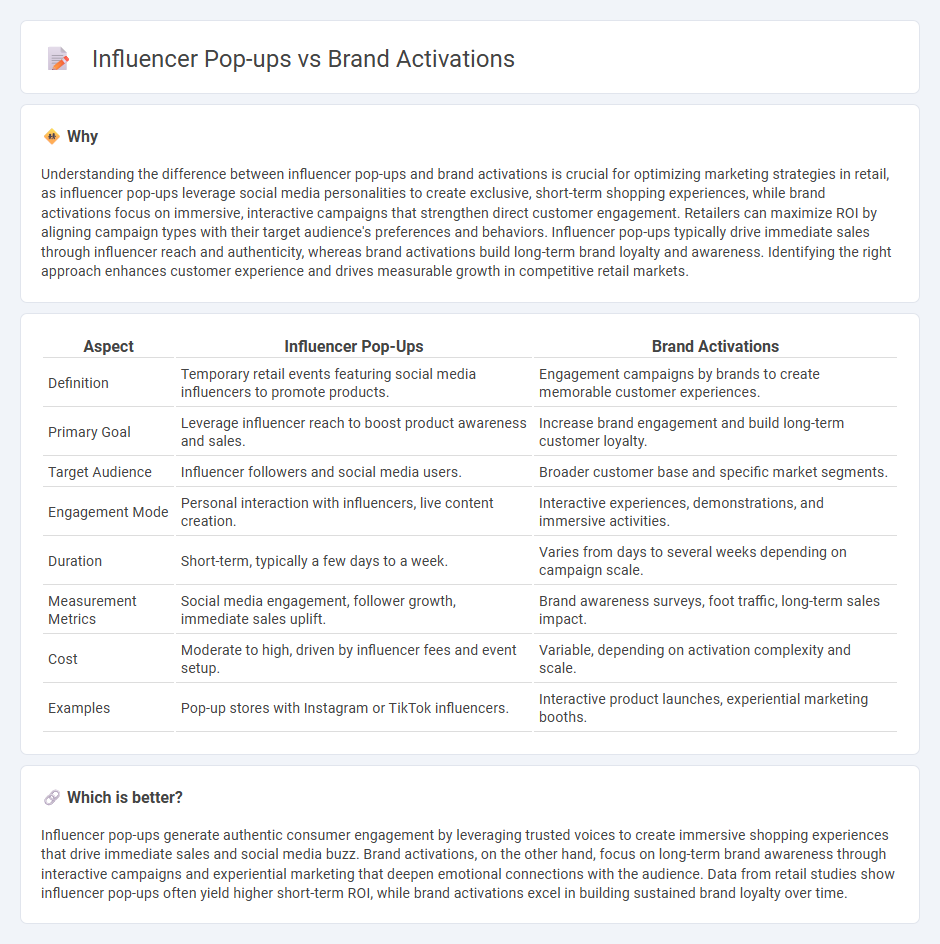
Influencer pop-ups leverage popular personalities to create immersive, limited-time retail experiences that drive immediate customer engagement and social media buzz. Brand activations focus on long-term strategies to establish deeper emotional connections through interactive events that showcase product benefits and brand values. Explore how these two approaches can transform your retail marketing strategy and boost consumer loyalty.
Why it is important
Understanding the difference between influencer pop-ups and brand activations is crucial for optimizing marketing strategies in retail, as influencer pop-ups leverage social media personalities to create exclusive, short-term shopping experiences, while brand activations focus on immersive, interactive campaigns that strengthen direct customer engagement. Retailers can maximize ROI by aligning campaign types with their target audience's preferences and behaviors. Influencer pop-ups typically drive immediate sales through influencer reach and authenticity, whereas brand activations build long-term brand loyalty and awareness. Identifying the right approach enhances customer experience and drives measurable growth in competitive retail markets.
Comparison Table
| Aspect | Influencer Pop-Ups | Brand Activations |
|---|---|---|
| Definition | Temporary retail events featuring social media influencers to promote products. | Engagement campaigns by brands to create memorable customer experiences. |
| Primary Goal | Leverage influencer reach to boost product awareness and sales. | Increase brand engagement and build long-term customer loyalty. |
| Target Audience | Influencer followers and social media users. | Broader customer base and specific market segments. |
| Engagement Mode | Personal interaction with influencers, live content creation. | Interactive experiences, demonstrations, and immersive activities. |
| Duration | Short-term, typically a few days to a week. | Varies from days to several weeks depending on campaign scale. |
| Measurement Metrics | Social media engagement, follower growth, immediate sales uplift. | Brand awareness surveys, foot traffic, long-term sales impact. |
| Cost | Moderate to high, driven by influencer fees and event setup. | Variable, depending on activation complexity and scale. |
| Examples | Pop-up stores with Instagram or TikTok influencers. | Interactive product launches, experiential marketing booths. |
Which is better?
Influencer pop-ups generate authentic consumer engagement by leveraging trusted voices to create immersive shopping experiences that drive immediate sales and social media buzz. Brand activations, on the other hand, focus on long-term brand awareness through interactive campaigns and experiential marketing that deepen emotional connections with the audience. Data from retail studies show influencer pop-ups often yield higher short-term ROI, while brand activations excel in building sustained brand loyalty over time.
Connection
Influencer pop-ups and brand activations are connected through their shared goal of driving consumer engagement and boosting brand visibility in the retail sector. Influencer pop-ups leverage the influencer's audience to create authentic experiences that attract foot traffic, while brand activations amplify these events by offering interactive, memorable moments that encourage purchases and social sharing. This synergy enhances customer loyalty and accelerates conversion rates by blending personal influence with strategic marketing efforts.
Key Terms
Experiential marketing
Brand activations create immersive experiences that engage consumers directly with a product or service, leveraging sensory interaction and emotional connection to build lasting brand loyalty. Influencer pop-ups capitalize on the social reach and credibility of key personalities, driving foot traffic and immediate consumer engagement through curated, shareable moments. Explore how these experiential marketing strategies can elevate your brand presence and consumer engagement.
Audience engagement
Brand activations drive deep audience engagement through immersive experiences that foster emotional connections and brand loyalty, leveraging interactive elements and real-time feedback. Influencer pop-ups attract targeted demographics by capitalizing on the influencer's community and social proof, creating buzz and immediate interest around products or events. Explore how these strategies can uniquely amplify your brand's audience engagement.
Collaborative partnerships
Brand activations leverage immersive experiences to engage consumers directly, fostering emotional connections through interactive events and product demonstrations. Influencer pop-ups emphasize collaborative partnerships by featuring influential personalities who attract targeted audiences and amplify brand reach via social media channels. Explore how integrating these strategies can maximize engagement and drive impactful marketing outcomes.
Source and External Links
13 Effective Brand Activation Examples - Brand activation creates emotional connections through interactive events, such as Atlassian's free trials, Spotify and Uber's collaboration, and Starbucks' influencer-powered pop-up store, leveraging experiential marketing to convert interest into loyalty.
+13 Brand Activation Examples for Top Luxury Brands - Brand activation is a marketing strategy focused on unique, engaging experiential campaigns like pop-ups and social media challenges that build awareness and loyal brand ambassadors, often incorporating creativity, technology, and surprising elements for maximum impact.
7 types of brand activations and why they are effective - Brand activation brings brands to life through participative experiences such as experiential marketing, sponsorships, guerrilla tactics, and influencer partnerships, aiming to make memorable emotional impressions that drive deeper customer engagement than traditional advertising.
 dowidth.com
dowidth.com